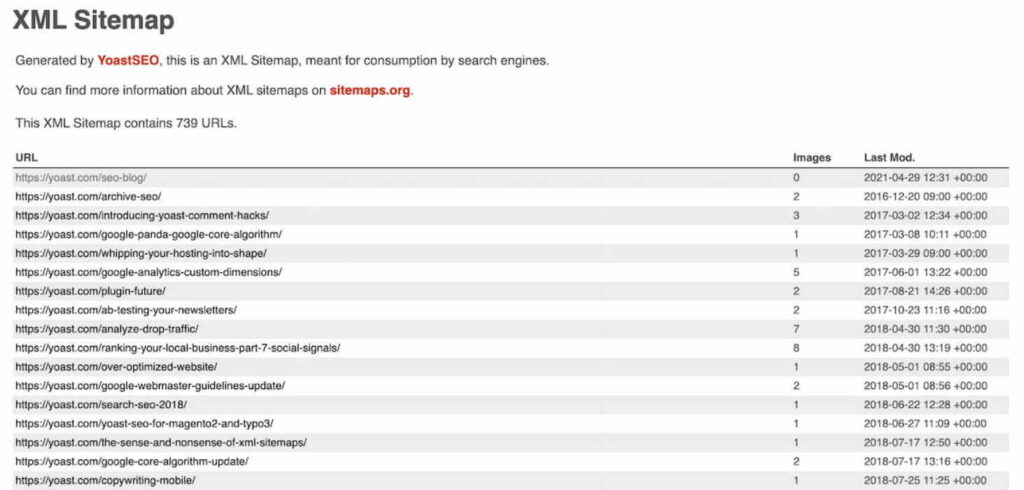What is an XML sitemap? Why is it Important for SEO?
An XML sitemap is a file containing a list of the web pages found on a website that’s arranged in order from the root (or home) page to a ‘top’ page.
A sitemap is a method for structuring and tracking pages in a website and is mainly used by webmasters or web crawling robots for navigating and navigating their website and finding out more about their site.
Adding a URL to a sitemap file does not guarantee that a URL will be crawled or indexed. However, it can result in the search engine discovering and indexing pages that it otherwise would not. This programme is a complement to, not a replacement for, the search engines’ normal operation.

Matt Cutts, the former head of Google’s webspam team, has explained XML sitemaps in the following way: Imagine if you had pages A, B, and C on your site. We find pages A and B through our normal web crawl of your links. Then you build a sitemap and list the pages B and C. Now there’s a chance (but not a promise) that we’ll crawl page C. We won’t drop page A just because you didn’t list it in your sitemap.
And just because you listed a page that we didn’t know about doesn’t guarantee that we’ll crawl it. But if for some reason, we didn’t see any links to C, or maybe we knew about page C, but the URL was rejected for having too many parameters or some other reason, now there’s a chance that we’ll crawl that page C.
Sitemaps use a simple XML format that you can learn at www.sitemaps.org. XML sitemaps are a useful and in some cases, essential tool for your website. In particular, if you have reason to believe that the site is not fully indexed, an XML sitemap can help you increase the number of indexed pages. As sites grow in size, the value of XML sitemap files tends to increase dramatically, as additional traffic flows to the newly included URLs.
How to create XML Sitemaps for Google?
When you create a sitemap, you’re essentially telling search engines which URLs you want to appear in search results. The canonical URLs are the ones that you should use. If you have the same information available at many URLs, select the one you want and include it in the sitemap instead of including all of them.
Once you’ve selected which URLs to include in the sitemap, you may generate it in one of the following ways, depending on the architecture and size of your site:
- Allow your content management system to produce a sitemap for you.
- You can manually generate a sitemap for sitemaps with fewer than a few dozen URLs.
- Create a sitemap automatically for sitemaps with more than a few hundred URLs.
If you’re using a content management system (CMS) like WordPress, Wix, or Blogger, it’s probable that a sitemap has already been made available to search engines. Search for information on how your CMS creates sitemaps, or how to construct a sitemap if one isn’t generated automatically. For instance, in the case of Wix, look for “wix sitemap.”
All other site layouts will require you to create your own sitemap.
You’ll need to build the sitemap if your sitemap has more than a few dozen URLs. A sitemap may be created using a variety of tools. However, having your website software produce it for you is the best option. You may, for example, extract your website’s URLs from its database and then export them to the screen or a file on your web server. Discuss this option with your developers or server management.
Check out our archived collection of third-party sitemap generators for coding ideas.
A sitemap isn’t examined every time Google crawls a site; it’s only checked the first time we see it, and then only when you ping us to let them know it’s updated. Only notify Google about new or updated sitemaps; do not submit or ping unaltered sitemaps several times.
Best Practices for XML Sitemap Optimization
The starting point of an optimized XML sitemap is having good URL structure and organization. Use only canonical URLs to avoid duplicate content problems and arrange them hierarchically to mirror your site’s natural hierarchy. Your URLs must be clean and descriptive, not having any unnecessary parameters or session IDs. Only use publicly accessible, indexable URLs – not login screens, search results, and other non-indexed pages.
Technical requirements are important for sitemap efficiency. Sitemap files should not exceed 50MB in size and should have fewer than 50,000 URLs. If your site is larger, split it up into several sitemaps and use a sitemap index file to handle them. You should use proper XML structure and namespace declarations, and validate your sitemap against XML schema before submission. For the best crawling, host your sitemap on your root domain.
Priority and change frequency settings must be given serious thought. Use the priority tag judiciously, saving higher values (0.8-1.0) for your most critical pages. Assign realistic change frequency values that truly represent how frequently your content is being updated. Steer clear of the trap of labeling all pages as high priority or daily updates across the board, as this can devalue your sitemap. Take seasonal content trends into account when deciding on update frequencies.
Common Mistakes to Avoid When Creating XML Sitemaps
While creating and optimizing your XML sitemaps, be aware of the following common mistakes:
Missing important pages: Double-check that you haven’t missed crucial pages or sections when generating your XML sitemap.
Incorrect or outdated information: Ensure that the information in your XML sitemap accurately represents the current state of your website.
Large and complex sitemaps: Avoid creating excessively large or complex XML sitemaps that could confuse search engine bots or slow down the crawling process. Google and Bing both have a limit of 50,000 URLs per sitemap. If you have more than 50,000 URLs, you will need to split your sitemap into multiple sitemaps.
Including URLs that are thin content. Thin content is content that is low-quality and does not provide much value to users. Search engines may penalize your site for submitting thin content URLs in your sitemap.
Not submitting your sitemap to search engines. This is one of the most important things you can do to ensure that your sitemap is crawled and indexed by search engines. You can submit your sitemap to Google Search Console and Bing Webmaster Tools.
Conclusion
In conclusion, XML sitemaps are indispensable tools in enhancing your website’s SEO performance. They provide search engine bots with clear guidance to navigate and index your site more effectively. By creating and optimizing XML sitemaps, you improve your chances of higher search engine rankings, faster indexing of new content, efficient hierarchical management, and enhanced user experience. With proper attention to XML sitemap creation and optimization, you can empower your website to reach its full SEO potential.

